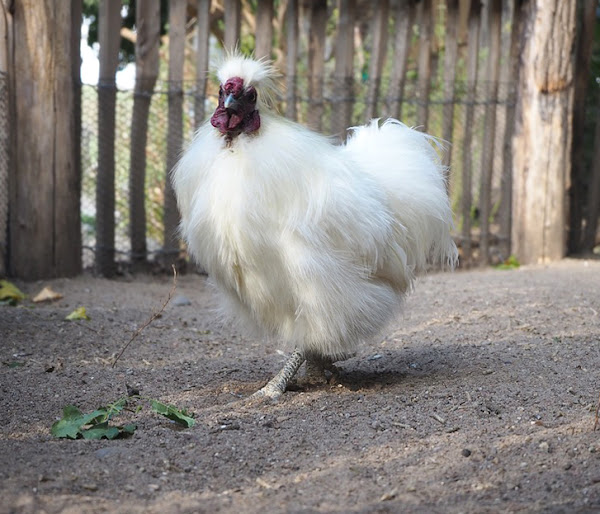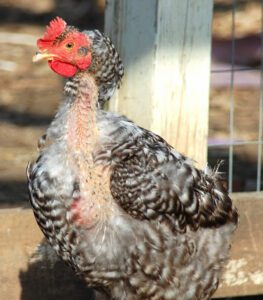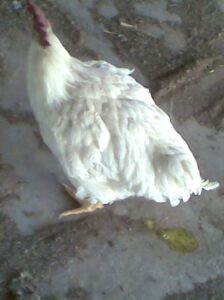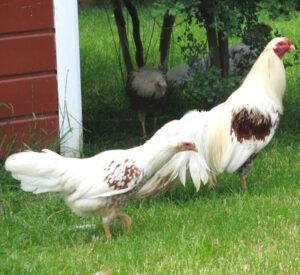Silkie chicken is one of the most popular and beloved ornamental chicken breeds. And it is currently one of the most entertaining birds to watch. The breed is also known as Silky.
It was named as Silkie chicken because of it’s a typically fluffy plumage, which is said to feel like silk. It has hair-like plumage, which is considered as actual mammalian fur. It is a very old Asiatic chicken breed.
Although the Silkie chickens have been around for several hundred years, but it’s origin is uncertain. The breed is thought be originated in China, India or Japan. The exact location from where they were developed or found is not known.
They arrived in Europe around 200 years ago, and reached the United Kingdom around the mid 1880s. Silkie chicken was first admitted into the American Poultry Association’s Standard of Perfection in 1874.
Silkie Chicken Full Breed Information
Today the breed is the most popular and ubiquitous ornamental chicken breed. And they are kept for both ornamental and exhibition purpose.

There is a bantam version of this breed. Review characteristics, behavior, temperament and full breed profile of Silkie chicken below.
Physical Characteristics
Silkie chicken is a very unique looking and beautiful bird. They are a lightweight chicken breed with broad, stout looking body which is covered in fine fluffy feathers.
Their plumage looks like fur or down instead of feathers. Because, their plumage lacks barbicels. Barbicels are the hooked projections normally extending from and interlocking the secondary branches of chicken’s feathers. Because of their such plumage, they are unable to fly.
As the breed is small in size, so they are mistakenly called a bantam breed in some countries. But it is a standard breed of large fowl class. And the bantam Silkie chicken is actually a separate variety. The Silkie chicken appears in two distinct varieties. Which are Bearded and Not-Bearded. Bearded variety has an extra muff of feathers under the beak area which covers the earlobes.
Silkie chickens are also separated according to color. White, Black, Partridge, Buff, Grey and Blue are the colors of Silkie chicken recognized for competitive showing. Other colors also exist, which include; Red, Splash, Cuckoo and Lavender.
According to the American Poultry Association’s Standard of Perfection, all the Silkie chickens have small walnut comb which is a deep mulberry approaching black. They have turquoise blue earlobes and dark wattles. They have black skin and bones and 5 toes instead of the normal 4.

Other chicken breeds which exhibit this rare 5 toe trait include; Faverolles, Dorking and Sultan. Their legs color is dark-blue with abundant feathering. Their flesh color is grayish-black.
Standard Silkie roosters weight about 1.8 kg and hens about 1.36 kg. And the bantam chicken’s weight vary depending on different standards. American Standard of Perfection calls for roosters that are 1 kg, and hens that are 0.907 kg.
The British Poultry Standard and Australian Poultry Standard call for much smaller bantam Silkies. According to the British Standard, the roosters weight 0.6 kg and hens 0.5 kg. And Australian Poultry Standard weight for bantam Silkies is 0.68 kg for roosters and 0.57 kg for hens. Photo from Wikipedia.
Behavior/Temperament
Silkie chicken is very calm, trusting and friendly. They are unable to fly and can be kept easily with low fencing. They usually do little or no damage to the garden if given them to access freely.
Silkie hens are not good layers. They lay a few cream or tinted colored eggs. But they are great mothers, and go broody frequently. They are even supremely happy to hatch the eggs of other birds. So they are frequently used as foster mothers for other birds.

Some poultry fanciers consider Silkie hens as the ideal organic incubator. Silkie hens cheerfully brood and raise their unorthodox offspring too, if given the chance. The hens stop laying eggs during the summer months.
The Silkie chicken should be kept in dry conditions, because their feathers are not waterproof. The breed is extremely suitable as pets, especially suitable for children. They are very cold hardy and also do well in confinement.
The breed was valued as a medicinal food item because of its black skin and bones. The average lifespan of Silkie chicken is around 9 years. Review full breed profile of Silkie chicken below.
| Breed Name | Silkie |
| Other Name | Silky |
| Breed Purpose | Ornamental |
| Breed Temperament | Bears Confinement Well, Calm, Easy to Handle, Friendly, Quiet, Docile |
| Breed Size | Large |
| Broodiness | Frequent |
| Comb | Walnut |
| Climate Tolerance | All Climates |
| Egg Color | Cream or Tinted |
| Egg Size | Medium |
| Egg Productivity | Medium |
| Feathered Legs | Yes |
| Rarity | Available |
| Varieties | Black, White, Grey, Blue, Splash, Buff, Partridge are the standard colors with many off standard & derivative colors in existence today. |
| Country of Origin | Thought be originated in China, India or Japan. |

Frequently Asked Questions
People ask many questions about silkie chicken. Here we are trying to list the most common questions about this beautiful chicken breed, and trying to answer them. Hope you will find your answer. Don’t hesitate to ask us if you have more questions.
What are silkie chickens good for?
The silkie chickens are good and known mainly for their beautiful and distinctive appearance. They are great layers and the hens are known for being the broodiest of all chicken breeds. They are also pretty good for meat production.
How much is a silkie chicken worth?
Depends on numerous factors, and exact price can vary from place to place. You can purchase these chickens for anywhere from $3 to $10 each.
Do silkie chickens like to cuddle?
Yes, they quite like being cuddled, kissed and groomed. These chickens are excellent as pets for young children.
Are silkie chickens good for beginners?
Yes, the silkies are very good for beginners. Silkies are actually great starter birds for anyone looking to begin their own backyard flock. Coop or housing requirement of the silkies are smaller than many other chicken breeds, so they are great for the beginners.
How long does a silkie chicken live for?
Average lifespan of the silkie chicken is between 7 and 9 years. Some birds have been known to live longer.

Are silkies noisy?
No, the silkies are not noisy at all. They are quiet and excellent as pets.
How many years do silkies lay eggs?
Depends on many factors. But generally the silkie hens consistently lay their eggs for around or up to 2 years. Their eggs production start to decline gradually.
Can you have silkie chickens as pets?
Yes, the silkies are very good in nature and fantastic as pets.
How long until a silkie is full grown?
The silkies generally take around 8-10 months to mature.
What are silkie chickens favorite food?
Favorite food of the silkies are corn and mealworms.
How many eggs do silkies lay a week?
Average egg production of the silkie hens is about 3-5 eggs per week.
Can you bathe a silkie chick?
Yes, sure! Occational bathing will help to keep the silkies healthy.
Can silkie chickens stay outside in the winter?
Yes, the silkies are cold hardy and they can stay outside in the winter.
Do silkies need heat in winter?
No, the silkies generally don’t need heat in winter, they are very cold hardy.
Can silkies be kept in the house?
Yes, the silkies are excellent as pets and their popularity as indoor pets is increasing gradually.
Are silkie eggs good eating?
Yes, eggs of these birds are good eating.
What color eggs do silkies lay?
Eggs of the silkie hens are cream or white in color.
Can you mix silkies with other chickens?
No, you should not mix silkies with other chickens.
How do you tell if a silkie is a rooster?
Silkie roosters are larger than the hens, and they develop a wattle earlier in life that grows larger than females’ wattles, and roosters have crown feathers while hens do not.
Do silkie chickens need a heat lamp?
No, the mature birds don’t need a heat lamp. The the chicks will need to remain under the heat lamp until 15 to 18 weeks of age.
How many eggs can a silkie chicken sit on?
The number can vary from 6 to 10 eggs.
How many eggs will a silkie hen lay before sitting on them?
Around or up to 10-12 eggs.
What breeds can live with silkie chickens?
You can keep Cochin and Polish chicken with your silkies.
Can silkie chickens eat apples?
Yes, silkies like to eat apples.
How long do fresh silkie eggs last?
The eggs will last up to 3 months from the day they have been laid.
How do you take care of silkies?
Caring for silkie chickens is very easy and simple. They must be kept dry and warm, as they are very fragile when they are young. Provide them with good and nutritious food and enough clean drinking water. Always try to keep their litter clean and dry. Vaccinate them timely and call vet if you notice anything uncommon.
How can you tell a female from a male silkie?
Silkie roosters are larger than the hens, and they develop a wattle earlier in life that grows larger than females’ wattles, and roosters have crown feathers while hens do not.
How big do silkies get?
Average body height of the mature silkies can be around 14 inches. And a fully grown rooster can reach around 36 ounces and a hen around 32 ounces.
What to do with silkies when it rains?
You should protect your silkies from rain. Don’t let your birds to go out during rain.
Are silkies intelligent?
No, they are not among the most intelligent birds.
How long do silkie eggs last in the fridge?
You can keep the silkie eggs in the fridge from around or up to 3 months.
What is the rarest silkie color?
Red is the rarest color of silkies.
What are the main characteristics of silkie chicken?
Some silkies have a crested head and are bearded and muffed The silkie has a blueish-black beak, black eyes, ashen-blue legs, small wattles and very small walnut or cushion combs. The silkie are known to go broody and lay few eggs. Another interesting feature of the silkie is its fifth toe.






